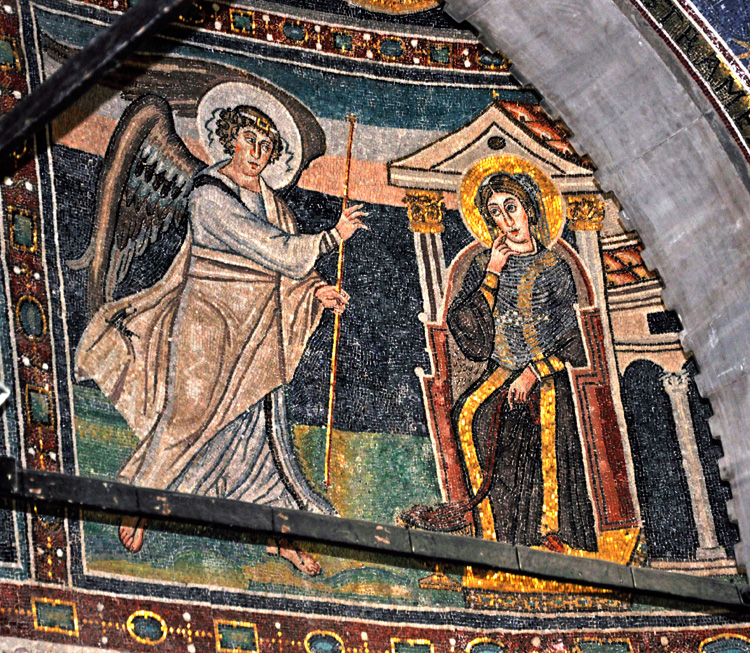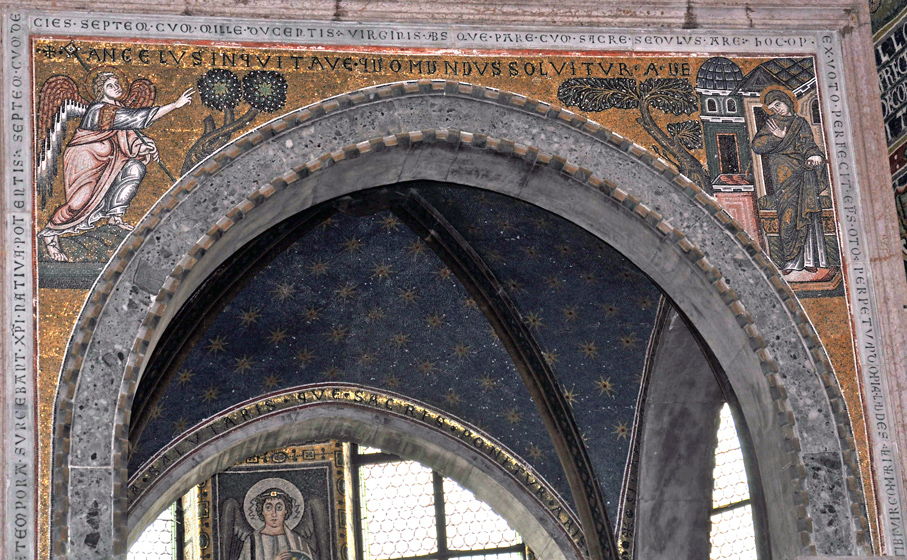The Two Annunciation Mosaics in the Apse of the Euphrasian Basilica


6th century and 1277
Euphrasian Basilica, Poreč, Croatia
The Annunciation was pictured on the inner wall of the apse in the 6th century and again in the 13th century above the arch of a new ciborium. The differences between the two reflect the changed emphases that arose in the medieval period.
First, the later mosaic establishes an architectural separation between the two figures, a feature that had become firmly attached to the iconography by the time of the 13th century. Second, the mosaics also differ in their references to the purple thread that the Protevangelium said Mary was spinning when the angel arrived. In the 6th-century version her chalice-shaped basket overflows with the thread she has been spinning. By the 13th century the influence of the Protevangelium on Annunciation images had faded considerably, and the only evidence of spinning in the ciborium is a small spindle Mary holds in her left hand.
Another difference may be due simply to the different stages in the narrative that the two artists chose to picture. In the apse, a seated Mary puts her hand to her cheek, registering her puzzlement at Gabriel's greeting (Luke 1:28-29). In the ciborium she signifies her positive response to Gabriel's news by standing up and making the palm-out gesture that conventionally signifies acceptance (Luke 1:38).
Otherwise, the iconography on the ciborium follows that on the apse wall. In both, the angel wears sandals and a pinkish mantle over a flowing white tunic; in both, he points to Mary with his fingers in the blessing configuration, perhaps signifying his words, "blessed art thou among women" (Luke 1:28). In both, Mary's throne is placed before a temple. Both artists chose not to include a dove to represent the angel's remark that "the Holy Spirit will come upon you" (Luke 1:35), even though a dove is seen as early as
the 5th-century Annunciation panel at Rome's Santa Maria Maggiore and came to be an indispensible element in medieval imagery. Finally, both artists attempt to unify the space that the two figures occupy — in the ciborium by adding trees on each side, and in the apse by continuing the gray and pink bands behind the angel into the spaces between the pillars of the temple.
The inscription above the ciborium is angelus inquit ave quo mundus solvitur a v[a]e, "The angel said 'Ave' ['Hail'], you by whom the world is saved 'a vae' ['from shame']. Dreves (#97, p. 143) prints a 15th-century verse that was sometimes added to the Salve Regina and that continued the pun by relating Ave and a vae to Eve: Felix mater, ave, qua mundus solvitur a vae / Quae genitrix Evae vae fecit omnia breve, "Hail blessed mother by whom the world is saved from the shame that mother Eve brought on all."
View the ciborium photograph in full resolution.
View the apse photograph in full resolution.
Read more about images of the Annunciation.
Photographed at the basilica by Richard Stracke, shared under Attribution-NonCommercial-ShareAlike license.